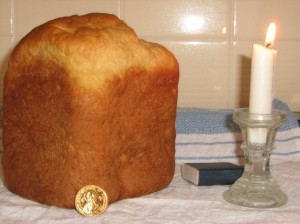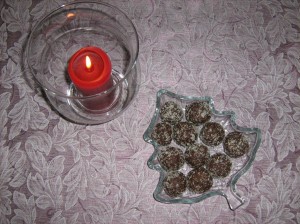New Year’s Bread – Vasilopita
 For many years now we have baked a Vasilopita (St Basil’s Bread) to mark the new year and St Basil’s Day on January 1st. As we have a Basil (Vasilios) in our house, it is also a Name Day celebration and a special time for us. In fact Vasilios has baked the bread himself now for the past fifteen years or so. When we became vegan, we modified the recipe so that it no longer included animal fats. We also modified it to bake in our bread machine as living in a hot climate does not exactly motivate one to want to knead dough and have the oven running for hours! There have been many trial runs but the recipe is now tried and true and we are pleased to be able to share it here. We also use this same recipe for Tsoureki at Easter, but I will post that version closer to the time.
For many years now we have baked a Vasilopita (St Basil’s Bread) to mark the new year and St Basil’s Day on January 1st. As we have a Basil (Vasilios) in our house, it is also a Name Day celebration and a special time for us. In fact Vasilios has baked the bread himself now for the past fifteen years or so. When we became vegan, we modified the recipe so that it no longer included animal fats. We also modified it to bake in our bread machine as living in a hot climate does not exactly motivate one to want to knead dough and have the oven running for hours! There have been many trial runs but the recipe is now tried and true and we are pleased to be able to share it here. We also use this same recipe for Tsoureki at Easter, but I will post that version closer to the time.
Vegan Vasilopita

Ingredients
3 teaspoons of orange zest
2 Tablespoons of orange juice
Egg replacer (Made up to be equivalent of one whole egg and one egg white.)
65ml soy milk
6 Tablespoons of vegan margarine (We have found a soy based one works very well but any dairy free margarine will work.)
2 teaspoons of aniseed juice (instructions below)
90g raw caster sugar
425g plain white flour
1 x 8g sachet of yeast
3 Tablespoons of warm water
Method
-
Prepare the aniseed juice by boiling 1 Tablespoon of aniseed in 1 cup of water for a few minutes, then strain and set aside. (This process is a bit like making tea.)
-
Zest finely one orange and set aside. (This should give you approximately 3 teaspoons of zest. We usually use large navel oranges, but Valencias work fine too.)
-
Juice the orange and set aside.
-
Prepare the egg replacer as per instructions on packet and set aside.
-
Prepare yeast by placing the 3 Tablespoons of warm water in a glass bowl and dissolving a pinch of sugar. Sprinkle the contents of the sachet into the water, swish about a bit then cover with a cloth and set aside out of drafts.
-
Measure out milk and set aside.
-
Measure out margarine, melt and set aside.
- Weigh the flour and set aside.
-
Weigh the sugar and set aside.
-
By now, the yeast should have started to activate (It will look a little bit fluffy/frothy.)
-
Place ingredients into the bread machine in the following order:
-
zest
-
juice
-
aniseed juice
-
egg replacer (you may need to whisk as it may have settled)
-
margarine
-
soy milk
-
caster sugar
-
flour
-
-
Make a small well in the top of the flour and tip the yeast on top.
-
Place pan into bread maker and select the sweet bread setting.
A note about bread machines…
We have two different bread machines. On one we simply choose the sweet bread setting. On the other we have to choose the size and crust, in which case we select 750g, light crust, then sweet bread. Unfortunately all machines are a little different so you may have to experiment with this aspect of the recipe.
Adding the Coin

Traditionally, new year’s breads have a coin hidden inside. We have found that it is easier to add the coin after the bread is baked by simply poking it up through the hole created in the base by the kneading pin in the machine. The little brochure that came with our coin has the following instructions, keeping in mind that the bread is traditionally baked in a circle. As we do not have this shape, we simply cut slices.
“ The head of the house will bless the Vasilopita with the cutting knife crosswise in the Name of the Father and of the Son and of the Holy Spirit. He will then cut the centre in a circle as an offering to our Lord Jesus, Who is first in our life. Then he will proceed to cut wedges starting with a piece for the Ever Virgin Mary, and for St Basil. Subsequently, a wedge for himself and all other members of his family and guests in succession. The one who finds this coin in his or her piece, is considered to be blessed especially for the New Year.”
This year the coin lay halfway between St Basil’s piece and Vasilios’ piece! (Photographic evidence below!)

Happy New Year to all our vvoc.org readers.
posted in Recipes, Saints | Comments Off on New Year’s Bread – Vasilopita
